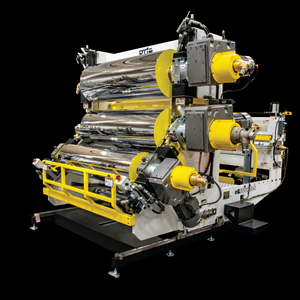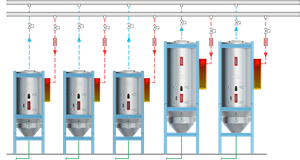Keeping Track of 4300 Products
Rowmark LLC in Findlay, Ohio, is an extruder of specialized sheet materials for engraving, architectural signage, awards, and identification.
Rowmark LLC in Findlay, Ohio, is an extruder of specialized sheet materials for engraving, architectural signage, awards, and identification. Originally a division of Hancor Inc., Rowmark became an independent company in 1997 and has since tripled in size, expanded from one extrusion line to three, and started new divisions supplying thermoforming and other specialty markets.
What has always distinguished Rowmark is its enormous range of choices of color, gauge, and surface texture–4300 different products, or SKUs (stock keeping units) in inventory jargon. “We’re a high-SKU, low-quantity manufacturer,” says president Duane Jebbett. That’s Rowmark’s competitive advantage, but it also became a major headache early on.
Of 4300 SKUs, only 300 are high-volume sheet products produced every three to four weeks. These account for 80% of sales. The other 4000 sheet products are sold a few at a time. The company specializes in coextruded, laminated, and custom products, including custom color matching.
BAR CODES TO THE RESCUE
From the beginning, Rowmark used enterprise resource planning (ERP) software from DTR Software (now part of Consona Corp. in Indianapolis). But the ERP system was oriented toward sales and purchasing. It kept track of sheet orders and raw-material purchasing, but didn’t effectively integrate production or manage inventory. As Rowmark grew, so did problems with shipping errors and customer complaints.
In 2001, Rowmark began a complete overhaul of its warehousing system. At the time, sheets were stored in cardboard boxes hand-marked with the part number. Orders were filled in two steps. One person counted the sheets by hand. A second person then recounted the order before it was shipped. But the second person had to rely on memory and eyesight for color and finish identification, which was nearly impossible with so many SKUs.
Rowmark extended its ERP software system with assistance from Integrated Manufacturing Systems Inc. in Merrimack, N.H., and converted from hand-written labels to barcoding for more accurate inventory management, stocking, reordering, and shipping. Rowmark installed new material storage racks and barcoded raw materials inventory, so that pulling resins and pigments no longer had to be done from memory.
At the same time, Rowmark worked with its largest customers to put them on an electronic data interchange (EDI) system, whereby they entered their own orders directly into Rowmark’s ERP system. Rowmark managed to channel 70% of all orders through direct EDI. This saved time and avoided errors from re-keying orders in-house. Improved accuracy with direct customer ordering translated into improved forecasting of product demand and production scheduling, using software from CorVu Integration (part of Rocket Software) in Edina, Minn.
“We have not conducted a wall-to-wall inventory count in more than four years,” says Rowmark materials manager Bob Holderman. “Instead, we audit the ERP system by counting finished products, raw materials, and work in progress in particular storage locations at regular intervals to verify the accuracy of the system.”
By 2007, these efforts were paying off. Rowmark had reduced finished goods inventory by 17%, increased inventory accuracy from 70% to over 99%, and improved the accuracy of filling customer orders from 80% to 99.7%.
Rowmark continues to enhance its ERP system. A year and a half ago, Rowmark added master scheduling software for production planning and scheduling. It also developed a very efficient order-picking methodology within the barcoding system. Now when the shipping department fills an order, the system sets the employee’s route through the warehouse, indicating the order in which products should be picked for optimum efficiency.
Barcoding has also improved, with an embedded identifier for each individual sheet, so packers no longer scan the top sheet 10 times when filling an order and then hand count and pull 10 sheets. The scanner has to identify each sheet, reducing the risk of errors.
Related Content
PTi Names Pasturczak Sales Manager
Pasturczak promoted to new role for sheet extrusion machine builder.
Read MoreRoll Stand is Compact, Flexible
Streamlined stack is joined by high-speed extruder; service cart for maintaining screws, dies and rolls; and other products.
Read MoreHow to Effectively Reduce Costs with Smart Auxiliaries Technology
As drying, blending and conveying technologies grow more sophisticated, they offer processors great opportunities to reduce cost through better energy efficiency, smaller equipment footprints, reduced scrap and quicker changeovers. Increased throughput and better utilization of primary processing equipment and manpower are the results.
Read MoreHow to Select the Right Cooling Stack for Sheet
First, remember there is no universal cooling-roll stack. And be sure to take into account the specific heat of the polymer you are processing.
Read MoreRead Next
Lead the Conversation, Change the Conversation
Coverage of single-use plastics can be both misleading and demoralizing. Here are 10 tips for changing the perception of the plastics industry at your company and in your community.
Read MorePeople 4.0 – How to Get Buy-In from Your Staff for Industry 4.0 Systems
Implementing a production monitoring system as the foundation of a ‘smart factory’ is about integrating people with new technology as much as it is about integrating machines and computers. Here are tips from a company that has gone through the process.
Read MoreBeyond Prototypes: 8 Ways the Plastics Industry Is Using 3D Printing
Plastics processors are finding applications for 3D printing around the plant and across the supply chain. Here are 8 examples to look for at NPE2024.
Read More













